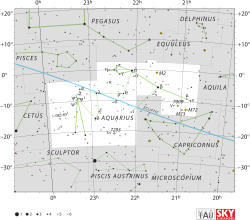| Observation data Epoch J2000 Equinox J2000 | |
|---|---|
| Constellation | Aquarius |
| Right ascension | 21h 39m 33.26758s[1] |
| Declination | +02° 14′ 36.8173″[1] |
| Apparent magnitude (V) | +5.09[2] |
| Characteristics | |
| Spectral type | K0 III[3] |
| U−B color index | +0.90[2] |
| B−V color index | +1.032[4] |
| Astrometry | |
| Radial velocity (Rv) | –34.63 ± 0.11[4] km/s |
| Proper motion (μ) | RA: –29.55[1] mas/yr Dec.: –83.22[1] mas/yr |
| Parallax (π) | 14.40 ± 0.30 mas[1] |
| Distance | 226 ± 5 ly (69 ± 1 pc) |
| Details | |
| Radius | 11[4] R☉ |
| Luminosity | 54[4] L☉ |
| Surface gravity (log g) | 2.5[4] cgs |
| Temperature | 4,721[4] K |
| Metallicity [Fe/H] | –0.17[4] dex |
| Rotational velocity (v sin i) | 2.5[4] km/s |
| Other designations | |
| Database references | |
| SIMBAD | data |
25 Aquarii (abbreviated 25 Aqr) is a single[3] star in the equatorial constellation of Aquarius. 25 Aquarii is the modern Flamsteed designation; in the past it held the designation 6 Pegasi.[6] It also bears the Bayer designation of d Aquarii. It is located near the border with the modern Pegasus constellation. Although faint at an apparent visual magnitude of +5.09,[2] it is bright enough to be viewed from suburban skies. Based upon an annual parallax shift of 0.01440 arcseconds,[1] it is located at a distance of around 226 light-years (69 parsecs) from Earth. The visual magnitude of the star is diminished by 0.09 from extinction caused by intervening gas and dust.[7]
The spectrum of this star matches a stellar classification of K0 III,[3] with the luminosity class of III indicating that this is a giant star that has evolved away from the main sequence after exhausting the supply of hydrogen at its core. It belongs to a population known as clump giants and hence is generating energy through the nuclear fusion of helium at the core.[8] The outer envelope has expanded to 11 times the radius of the Sun and it is radiating 54 times the Sun's luminosity.[4] This energy is being emitted from the stellar atmosphere at an effective temperature of 4,721 K,[4] causing it to glow with the orange hue of a K-type star.[9]
- ^ a b c d e f Cite error: The named reference
aaa474_2_653was invoked but never defined (see the help page). - ^ a b c Cite error: The named reference
mnras133_475was invoked but never defined (see the help page). - ^ a b c Cite error: The named reference
mnras389_2_869was invoked but never defined (see the help page). - ^ a b c d e f g h i j Cite error: The named reference
aj135_1_209was invoked but never defined (see the help page). - ^ Cite error: The named reference
SIMBADwas invoked but never defined (see the help page). - ^ Cite error: The named reference
jha18_3_209was invoked but never defined (see the help page). - ^ Cite error: The named reference
aaa430_165was invoked but never defined (see the help page). - ^ Cite error: The named reference
apj539_2_732was invoked but never defined (see the help page). - ^ Cite error: The named reference
csirowas invoked but never defined (see the help page).
